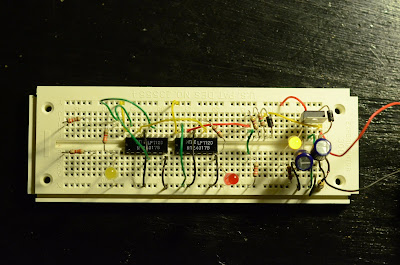In the past post, I gave the full schematic of the nixie clock, but I did not completely explain the resistor that goes from the "neutral" lead to ground. That was simply because I wasn't sure what it was for!
Turns out the transformer is not a 9VAC transformer, but a 24VAC transformer instead! The resistor is voltage dividing the output to 9V. This wouldn't be a problem, except that when pulling higher currents from the transformer for, say, turning 9VDC into 170VDC, the current prefers to pass through the resistor instead of powering the device!
Basically, I would read no voltage from the transformer when I hooked up the Boost Converter. Arrgg.
Before realizing the purpose of the resistor, I removed the resistor and gave it a shot. Yay, I get 170VDC from the boost converter, but I found out a few days later that I ended up frying the decade counter IC's with 12+ VDC. Whoops!
So, what did I do? First I thought I would wind a new coil out of the existing one. I found this
awesome tutorial on how to change the output voltage of the secondary coil by reducing the number of windings. After chiseling away the laminated segments of the core one by one, unwinding the mess of wire for the secondary to count how many turns there were, rewinding a fewer number of turns, and finally jury-rigging back the laminated segments, I got a nasty looking temperamental ugly stepchild of a transformer which jiggled and rattled at 60Hz on my desk like a buzzing bee! Yeah, it outputs 12VAC, but there is no way this thing is going in the final clock unless it ends up being an alarm feature. Yeah, I learned how these transformers are constructed, but in reality, I think I wasted about 3 hours of my time.
In defeat, I went out and bought an appropriate 120VAC to 12VAC transformer from RadioShack for around $3. I will post pictures of the reconditioned device soon.
share on:
facebook











